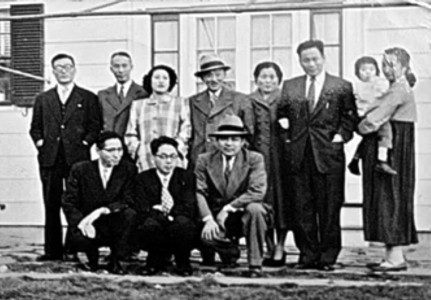The Korean Society of Boston
The number of Korean immigrants to the United States grew noticeably after the Korean War armistice in 1953, due in part to various scholarships granted by American missionaries and other institutions to promising students from South Korea. For example, in 1956 Boston University established a scholarship for Korean students in honor of the alumnus and ambassador to the United States, Dr. Yang Yuchan.[1] The development of the Korean intellectual community in the Boston area in the 1950s, however, was largely attributable to Korean graduate students and visiting scholars at the Harvard-Yenching Institute.[2] In 1953, the Yenching Institute—an independent foundation at Harvard University dedicated to promoting higher education in Asian studies—began to offer generous fellowships to post-doctoral scholars from South Korea.

The Korean Society of Boston was established in 1953 by the joint efforts of Dr. Seo Du-su (1907-1994) and Dr. Ko Kwang-lim (1920-1989). At the time, Dr. Seo was a visiting professor at the Harvard-Yenching Institute and Dr. Ko was a doctoral candidate at Harvard Law School. Both men saw a need to form an organization for the Korean diaspora in the Boston area to provide practical and emotional support to Koreans, as well as to build relationships with one another in anticipation of future collaboration as leading intellectuals in the United States. Dr. Seo was elected as the first president and Dr. Ko the vice-president. It is noteworthy that the Korean Society and the first Korean Church of Boston were founded on the same day, Thanksgiving Sunday, 1953.[3] There was a significant overlap of key leaders in these two organizations, illustrating the role of the church as a place of comfort, support, and fellowship for the diaspora community. The Korean Society also worked closely with the Korean Students Association, organized in that same year by Harvard architecture student Cho Jaryong.[4]
Dr. Ko recalls some of the crises that affected Koreans living in the Boston area in the 1950s and the need for an organization to support the diaspora community. |
|
Before coming to the Boston area, Dr. Seo had served on the faculty of Seoul National University and Yonsei University in Seoul, Korea, from 1945 through 1949. In 1949, he entered the Ph.D. program in education at Columbia University in New York City. After completing his doctorate in 1952, he moved to Harvard University as Visiting Associate Professor of Korean Studies. He obtained this position with the help of Dr. Ko, then a doctoral candidate at Harvard Law School, who recommended Dr. Seo to Dr. Edwin O. Reischauer, then an acting director of the Harvard-Yenching Institute.[5] As the first professor of Korean Studies at Harvard, he taught Korean language and literature for three years. One of Dr. Seo’s students, Edward Wagner, later founded the Korea Institute at Harvard in 1981.[6]
In 1955, Dr. Seo moved to the University of Washington in Seattle as Professor of Korean Literature.[7] Dr. Ko became the second president of the Korean Society. As a public figure representing the Korean intellectual community in Boston, Dr. Ko openly criticized the Rhee Syngman dictatorship and called for full-fledged democracy in South Korea.[8] His relentless efforts were recognized by South Korean Prime Minister Jang Myeon, who took power after the April 19 Movement in 1960, and Dr. Ko was appointed as Ambassador to the Korean Embassy in Washington, D.C.[9] When Dr. Ko left Massachusetts to begin his diplomatic service in Washington, Kim Seongha was elected the third president of the Korean Society. Interestingly, Kim married the daughter of Dr. Seo, illustrating that professional and personal relationships among these intellectuals were often interlinked.
Written by: Daewon Moon
Edited by: Doug Tzan
Citations
[1] “Alumni to Fete Ambassador, Establish Korean Scholarship,” Boston University News, February 7, 1956.
[2] New England Centennial Committee of Korean Immigration to the United States, ed. History of Koreans in New England (Seoul: Sonhaksa, 2004), 58.
[3] “History of Korean Society of New England,” Korean Society of New England, http://www.bostonks.com/index.php?mid=intro (accessed March 25, 2013).
[4] History of Koreans in New England, 286.
[5] Hesung Chun Koh, “East Rock Institute and Harvard Korean Studies Program” (April 17, 2006), http://koreaweb.ws/pipermail/koreanstudies_koreaweb.ws/2006-April/005556.html (accessed March 25, 2013).
[6] “History of the Korea Institute at Harvard University,” Korea Institute at Harvard University, http://korea.fas.harvard.edu/about-korea-institute-harvard-university (accessed March 25, 2013).
[7] “History of the Korea Studies Program at the University of Washington,” Center for Korea Studies of the University of Washington, http://jsis.washington.edu/korea/koreahistory.shtml (accessed March 25, 2013)
[8] Jong-Moo Cho, “Dr. Kwang Lim Koh: Scholar and Community Leader,” The Korea Times, October 6, 2011, http://www.koreatimes.com/article/688328 (accessed March 25, 2013).
[9] Ibid.